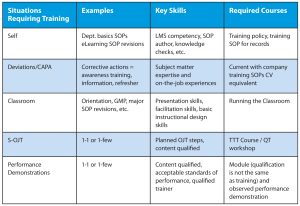
Technology – By Vivian Bringslimark
Do subject-matter experts need to be qualified trainers?
 Question for you: Does every subjectmatter expert (SME) need to be qualified as a trainer?
Question for you: Does every subjectmatter expert (SME) need to be qualified as a trainer?
In the life sciences arena, there are five recurring situations that require training: self, corrective actions, classroom (instructor-led training), structured on-the-job (SOJT) and qualification events (performance demos). Let’s look at those, through this article and the accompanying chart.
Self
Self can be achieved by the individual reading the procedure and then signing the training record. This is also known as read and understand for standard operating procedures.
I personally don’t think of it as training; it’s reading. In some situations, reading is all that is required to gather the information. If, on the other hand, you need to execute the steps of the procedure and complete required forms, then additional training with the procedure author or a qualified trainer is the appropriate next level of training.
Corrective Actions
Deviations or corrective actions derived from a corrective action or preventive action investigation. Minimally a SME or the standard operating procedure author is needed to ensure credibility of the content.
These types of training sessions have become known as corrective actions “awareness” training. More and more SMEs are now being required to deliver this training in a classroom setting. They need to be qualified to deliver classroom sessions, especially if the event is related to a significant corrective action or preventive action (CAPA) or regulatory inspection observation. These SMEs need an additional workshop focused on the SME as classroom facilitator.
Instructor-Led
Classroom (instructor-led training) is preferred for knowledge-based content affecting a wide range of employees. Instructor-led training requires training in learning theory design and practice in what used to be referred to as platform skills. Today, it is more commonly known as “running a classroom” or “basic facilitation skills.” Think Good Manufacturing Practices (GMP) refresher sessions in a classroom, either faceto-face or virtual.
Years ago, it was a lot clearer to distinguish between classroom trainers and SMEs as on-the-job-qualified (OJT-qualified) trainers. Classroom trainers delivered their content in a classroom of many learners using slides, flipcharts and handouts. They were usually full-time dedicated training staff. OJT was delivered one-to-one by following Joe/Jane around. Today, OJT is becoming a formal process within a robust training system.
Structured On-the-Job
Structured OJT is on-the-job training delivered by a qualified OJT trainer using the approved methodology. OJT-qualified trainers attend the qualified trainers workshop, which focuses on the OJT steps model, how to teach complex equipment-focused procedures and the challenges of life as a qualified trainer.
Trainer’s Grid
Qualification Events
Qualification events (the final performance demonstration) are formally documented observations of learners performing the procedure or task at hand in front of a qualified OJT trainer using an approved OJT checklist or rubric. It is these events that set apart a technical SME from an OJT- qualified trainer. The qualified trainers workshop includes a dedicated lesson on what to look for during qualification events and what the qualified trainer’s signature means for the integrity of the employee qualification program.
Becoming Duo-Purposed
Many of today’s OJT-qualified trainers are being requested to deliver “group training” sessions on revisions and content within their SOPs. While the target audience may be the same set of peers, the scope, objectives and tools used to deliver instructor-led training are vastly different.
Having positive experiences with group training, several OJT- qualified trainers are stepping up and volunteering to attend the SMEs as classroom facilitators as part of expanding their qualified-trainers toolkit. Many of them want to learn more about teaching peers and working with adults in an instructorled training session. A few have now been promoted to full-time trainers for learning or quality assurance departments.
Which of your OJT-qualified trainers are ready to step up and move into instructor led training? It’s time to find out.
Vivian Bringslimark is a principal with HPIS Consulting and a member of the LTEN QRDM Training Committee. Email Vivian at vivianbring@comcast.net.









